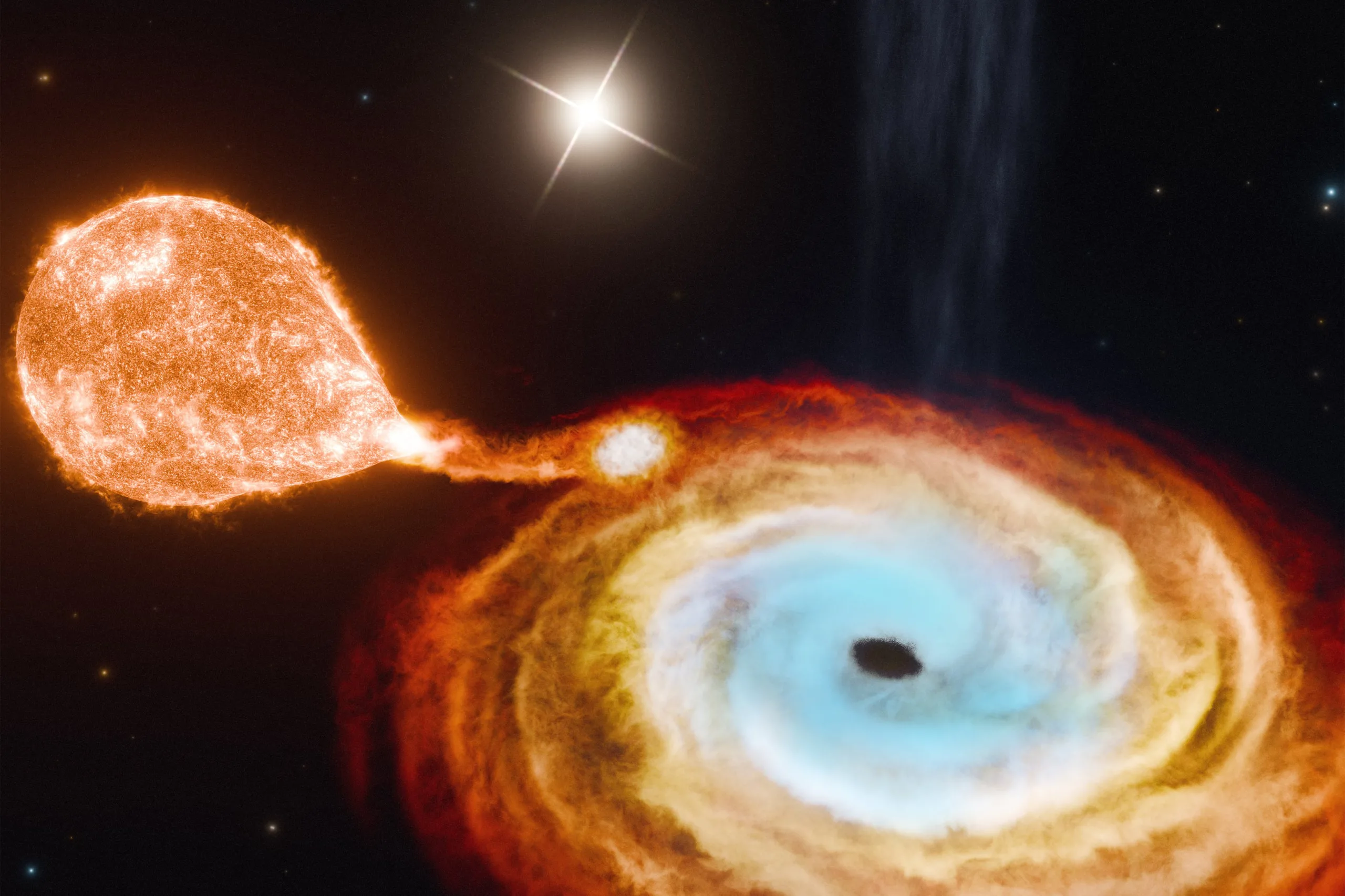Most black holes identified so far exist in pairs, forming binary systems composed of a black hole and a companion object, which can be a star, neutron star, or even another black hole. These celestial bodies orbit each other, held in a gravitational embrace by the black hole’s immense pull.
In an exciting new development, physicists from MIT and Caltech are broadening our understanding of black holes and their formation. Their latest research, featured in Nature, unveils the first observation of a “black hole triple.” This intriguing system consists of a central black hole that is actively consuming a small star, which orbits very closely—a cycle occurring every 6.5 days. Remarkably, a distant second star also orbits this black hole, completing its orbit approximately every 70,000 years.
The presence of such a distant companion challenges our assumptions about black hole formation. Traditionally, black holes are believed to originate from the explosive aftermath of dying stars in a catastrophic event known as a supernova, a spectacular burst of energy and light that leads to the formation of an invisible black hole.
However, the discovery suggests that if the observed black hole formed from a typical supernova, the energy released would have expelled any loosely bound objects from its vicinity. Hence, the existence of this far-off star raises intriguing questions about the black hole’s origins.
The researchers propose an alternative process called “direct collapse,” wherein a star collapses quietly without the dramatic explosion associated with a supernova. This gentler collapse might allow distant objects to remain gravitationally tethered, explaining the presence of the outer star.
“While most black holes are thought to result from violent stellar explosions, this finding invites us to reconsider that understanding,” explains study author Kevin Burdge, a Pappalardo Fellow in the MIT Department of Physics. “This discovery is thrilling for black hole evolution and prompts inquiries into the existence of other triple systems.”
Among the co-authors from MIT are Erin Kara, Claude Canizares, Deepto Chakrabarty, Anna Frebel, Sarah Millholland, Saul Rappaport, Rob Simcoe, and Andrew Vanderburg, alongside Kareem El-Badry from Caltech.
The Surprise Discovery
The identification of this black hole triple was largely serendipitous. The researchers were utilizing Aladin Lite, a platform that aggregates astronomical data from various telescopes globally, to explore potential new black holes in our Milky Way galaxy. While investigating the well-studied black hole V404 Cygni, which lies about 8,000 light years from Earth, Burdge stumbled upon two distinct clusters of light in the images.
The first cluster was identified as the black hole and its closely orbiting inner star, which is currently shedding material onto the black hole—not surprisingly, this star emitted visible light. The second cluster, which had previously been overlooked, was determined to be a far-off companion star.
“The fact that we can distinctly observe two stars separated by such distance implies they are incredibly far apart,” Burdge notes, explaining that the outer star is an astonishing 3,500 astronomical units (AU) away from the black hole—this is 3,500 times the distance from Earth to the Sun, or one hundred times the distance from this outer star to Pluto.
This raised the critical question of whether this outer star was indeed linked to the black hole and its inner counterpart. To delve deeper, the researchers analyzed data from the Gaia satellite, which has meticulously tracked star movements since 2014. Their investigation revealed that both stars moved in a synchronized manner over the past decade, demonstrating a connection with probabilities of occurrence at about one in ten million.
“The observed tandem motion strongly indicates they are bound together by a weak gravitational connection,” Burdge asserts, affirming the system’s triple nature.
Theoretical Foundations
How could such a system have formed without losing the outer star? If the central black hole emerged from a typical supernova, one would expect the violent explosion to have ejected the outer star long ago.
“Picture pulling a kite with a sturdy string versus a fragile cobweb: if you tug too hard on the fragile material, it breaks, and you lose the kite,” Burdge compares, emphasizing that any dramatic event influencing the inner binary would likely result in the loss of the outer companion.
To further investigate, Burdge conducted simulations involving various scenarios of star evolution, where the third star once existed as a regular star before transforming into a black hole. Through countless iterations, it became evident that the most plausible way for this triplet to exist is through the direct collapse process.
Beyond revealing insights into the black hole’s origin story, the outer star also hints at the age of the system. Researchers observed that the outer star is transitioning into a red giant, a late stage in stellar evolution, which allowed them to estimate that this star—and thus the entire black hole triple—has an age of around 4 billion years.
“This is data we’ve never before had for an ancient black hole,” Burdge elaborates. “Now, with V404 Cygni as a triple system, we propose it likely formed via direct collapse approximately 4 billion years ago.”
This pioneering research was partially funded by the National Science Foundation.
Photo credit & article inspired by: Massachusetts Institute of Technology



